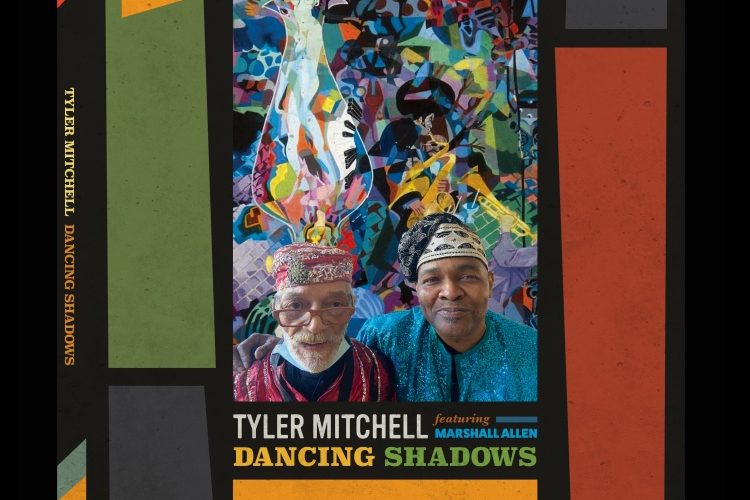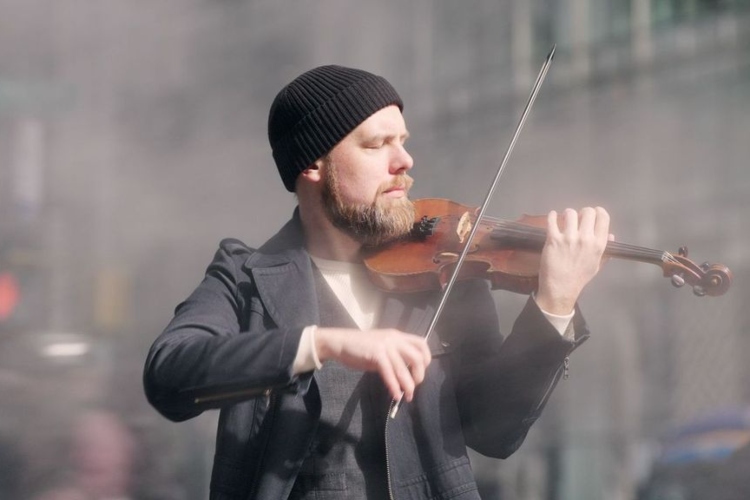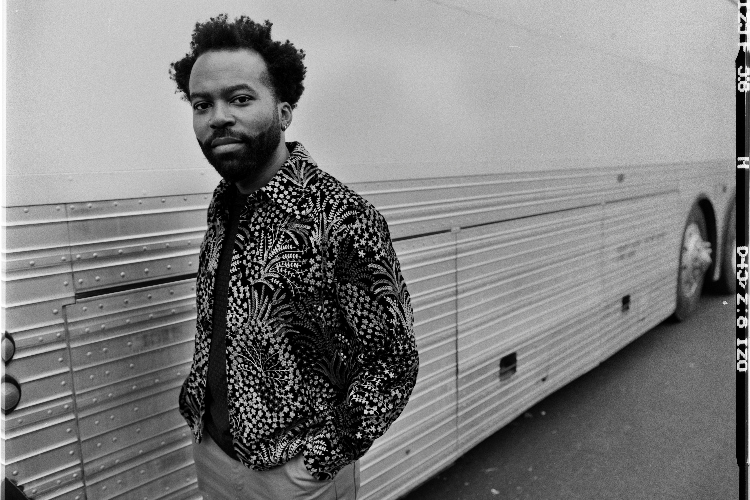Orbital Rings of Saturn: A Conversation with Tyler Mitchell and Marshall Allen (Part One)
|
Getting your Trinity Audio player ready...
|
“I never wanted to be a part of planet Earth, but I am compelled to be here, so anything I do for this planet is because the Master-Creator of the Universe is making me do it. I am of another dimension. I am on this planet because people need me.”- Sun Ra
Throughout his life, Sun Ra consistently claimed birth on the planet Saturn. While a credentialed astronomer would likely question the veracity of his claims, the pianist/composer/musical innovator’s legacy in bringing the alien and foreign into the jazz tradition is without question. Sun Ra was an icon of Afrofuturism, if not its originator. With his various incarnations of the Arkestra, he breathed new life into the, then, mostly stale, big band form. He experimented with the electric bass, electronic keyboards, rhythm machines, and synthesizers over a decade before Miles and others “went electric.” Even limited to acoustic sounds, Sun Ra was among the first bandleaders to use two double basses and to present freeform group improvisations. But perhaps his most significant contribution to music was his sonic language. His unique use of tones is identifiable regardless of the size of the ensemble. While Sun Ra returned home twenty-nine years ago, his fellow astral travelers keep his message alive with the Arkestra and the musical ideas of its members. Tyler Mitchell’s Dancing Shadows featuring Marshall Allen (Mahakala Music, 2022) persuasively shows this enduring legacy.
In a way, Mitchell and Allen traveled different, but partially overlapping, treks along the spaceways. Mitchell, also a go-to bassist for some heavyweights of straight-ahead music, first left orbit in 1985, only to later return and then voyage out yet again over the last decade. The now 97 years young saxophonist, Allen, has remained a trusty navigator since 1958. In 1995, he became commander of the Arkestra ship.
Despite the artists’ somewhat divergent trajectories, their collaborations often scream Sun Ra’s influence. Dancing Shadows digs deep into the essence of the pianist’s music, more than just specific notes. Half of the album consists of Sun Ra compositions. But, due to the sextet’s instrumentation, they are reimagined. The original arrangements are fractured and reassembled. The band spreads the absent piano’s essence among the three horns. Original compositions come from the heart of collective improvisation, which played such a central role in Sun Ra’s music.
In this first of our two-part conversation with Mitchell and Allen, we discuss the excellent album and the process of its creation. With the inclusion of someone as culturally significant as Allen, we also adopted a broader perspective, covering not just the Arkestra but also his first time meeting Sun Ra and the years since.
PostGenre: How do you both feel the pandemic has shaped your music?
Marshall Allen: Pandemic? Well, I just got my booster shot. It kicked my ass too. The first day wasn’t so bad, but the next day hit me hard. I’ve been staying in the house. That booster shot got me down today, so I’ve been doing a lot of sleeping.
Tyler Mitchell: The pandemic got me sort of more underground. We weren’t performing anymore, so we were just practicing a lot more. I spent a lot of time trying to practice. To woodshed for real, you know? And we still haven’t gotten back to really working again yet.
PG: Marshall, since you mentioned your home, maybe you could provide an update on how it is doing. It is a special place. For over half a century, it has been the headquarters for the Sun Ra Arkestra. It has been a space where the band’s members have lived, rehearsed, and explored music. The home partially collapsed in March of last year. Has it been fully repaired?
MA: We are still working on it. You get charged so much money to fix up a place. I mean, I just had a new cabinet put in. Boom $1,800. And, next, I have a new stove coming in. Another $800. It all adds up. But the biggest thing was my basement floor, and they fixed that.

PG: Are there any plans to turn the home into a museum since it is so historically significant?
MA: Yeah, maybe at some point. There is so much important stuff here. But I’m still working here.
PG: Yes, you’ve been with the Arkestra for almost 64 years now and are still going strong.
MA: Since 1958, but closer to 63 years. Before then, I served in Europe with the army. I was stationed in France with the 92nd Infantry. After [World War II], I spent two or three years studying in a conservatory in Paris with funding provided by the GI Bill. When I returned, I came back to Chicago. And that is where I first met Sun Ra. At the time, Sun Ra was looking for people to play his music. There wasn’t a lot of work in those days. You would do a lot of playing but would not make much money. But it was a good workshop. You would learn to play how he wanted you to approach his music. And I wanted to be a part of it, so I took my horn over to him and told him that I wanted to join.
PG: Did you immediately recognize that he was doing something special?
MA: I heard the music, and that was it! His music was so different than other stuff I had been playing at that point. With Sun Ra’s music, you do different things with the notes than in most music. And it’s those different things with the notes that give his music such a distinct sound. All the great big band leaders had their own distinguishable sound. When you hear Duke [Ellington], you can tell it’s Duke because of how the notes sound. Same with Count Basie. And the same with Sun Ra. And I had to learn how to fit into his sound.
PG: Marshall, you have spent most of your career with the Arkestra. Although you’ve explored other projects as well, do you have any regrets about staying with one band for so long?
MA: Each day, I just play the vibrations I feel that particular day. The way music is, you play the music the way you feel it. I used to focus on notes and technique, but it is the spirit of them that matters. That is what lets you distinguish between bands just by hearing them. And the ability to get to the spirit of the music is what working with the Arkestra has given to me.
Sun Ra would often make me listen instead of just playing. He did that because, when I was young, I thought I knew everything. But I didn’t. It’s kind of like raising kids; you don’t want them coming up thinking that they know everything because then there is a lot they will never learn. And once I began to really listen, that’s when I could get to the spirit of the music.
I don’t have any regrets because staying with the Arkestra gave me that ability to play the real spirit of music. I could play the notes or technical things anywhere, but I’m not sure working with other groups would have given me the ability to get to the spirit of the music as much as I had by staying with the Arkestra.
PG: You both personally worked with Sun Ra. What do you feel you learned the most from working with him?
MA: Sun Ra taught me how to have some discipline. He had to give me a few different kinds of discipline when it came to playing his music. [Laughing] He also taught me how to pronounce the music as if I am speaking it.
TM: I learned that there is no such thing as a “wrong note.” It’s all about how you follow that “wrong note.” He freed me up in a way. As Marshall said, that takes a lot of discipline. But there is a lot of freedom too, especially in seeing what works and what doesn’t.
MA: And to a large extent, you learned about yourself from working with Sun Ra. He tailor-made his music to fit the personality of the people playing it. Whoever he had, he made their part just for them.
PG: Like Duke Ellington, in terms of composing for the specific musician instead of a generalized instrumental voice.
MA: Exactly, that’s a lot of the stuff he did. And that makes you learn more about your musical strengths, weaknesses, and interests.
TM: And it makes you want to play the part more too, knowing that it was tailor-made for you just like a suit.
PG: Somewhat related to that, Tyler, what have you learned from Marshall?
MA: Well, I don’t know [laughing]
TM: I’ve learned so much from Marshall.
MA: And I’ve learned stuff from him!
TM: I’ve learned to open up and take more chances. To be more assertive about music. But I’m still learning. Marshall’s showing me stuff all the time. He’s a constant teacher.
PG: And you can see that mutual teaching and conversation on Dancing Shadows. What was the process for making the album?
TM: For a long time, I had asked Marshall if he would do a project with me if I were to put some musicians together. I started working on several compositions by Marshall and Sun Ra, getting the band together and rehearsing. Just getting everything arranged. And then we went into the studio. That’s how Dancing Shadows came together.
PG: Was it strange to have a role reversal of the Arkestra, in the sense that with that band Marshall is the leader but, here, Tyler is the leader?
TM: We didn’t think about it like that. We were just playing together. We ultimately all need each other. And that’s also true if we were playing with the full Arkestra.
MA: That’s right.
PG: Was it more difficult to play some of these Sun Ra compositions with a smaller ensemble compared to the larger Arkestra?
MA: Well, you know, when we got to New York in the 1960s, we only had a seven-piece band. It was Sun Ra on piano with trumpet, three saxes, bass, and drums. And sometimes we only had four or five people.
TM: The band was kind of small, like this group.
MA: Yeah. We had six people on this record, so not that different in size. Of course, the Arkestra is a lot bigger. We’ve even performed at Central Park once with a band of a hundred musicians. But the idea of playing these pieces with a smaller group isn’t something new. In some ways, playing with a smaller group goes back to at least the early 1960s. It’s not harder to do this with a smaller group, you just have to play different parts than with the full Arkestra.
TM: You have to learn your part.
MA: Yeah, you learn your part, I learn my part, and we go off!
Click here for the second part of our conversation with Tyler Mitchell and Marshall Allen.
Tyler Mitchell’s Dancing Shadows Featuring Marshall Allen will be available on January 28, 2022, on Mahakala Music. It can be purchased on Bandcamp. More information about Tyler can be found on his website. There is also more on Tyler, Marshall, and the Sun Ra Arkestra on the Arkestra’s website.




4 thoughts on “Orbital Rings of Saturn: A Conversation with Tyler Mitchell and Marshall Allen (Part One)”